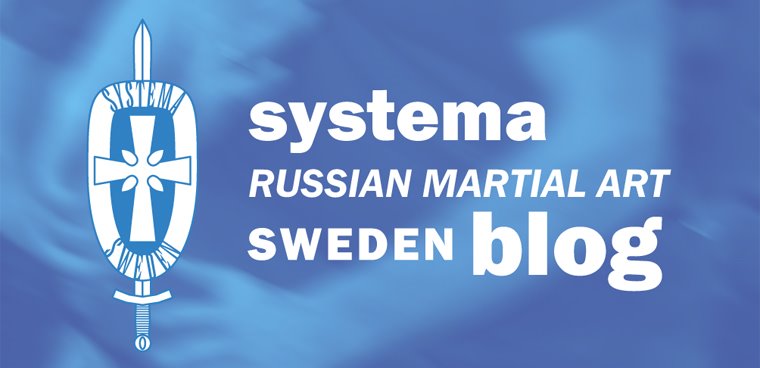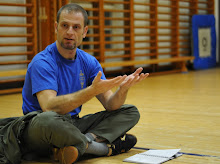So, let’s now move ahead to
Rules set #3: Victor Spiridonov's Combat SAMBO fighting strategy
Before we begin to analyze the Combat SAMBO strategy (the “single algorithm of actions used in warding off an onslaught” – more on this later), it would be a good idea to try and explain the historical framework under which SAMBO and what we currently refer to as Russian Martial Art were developed, and the connections between those two. Most people tend to believe that SAMBO (a Russian acronym meaning "self-protection without weapons" - SAMozashchitya Bez Oruzhiya) was developed as a pure grappling style in the 1930s Soviet Union, by Kodokan judo black belt Vassili Sergeevich Oschepkov and Victor Afanasievich Spiridonov, an officer of the Russian Army, who combined elements of Japanese jujitsu, judo, Greco-Roman and freestyle wrestling with techniques taken from the various native wrestling styles of the older Soviet republics (such as the Georgian chidaoba, Armenian koch and Tatar kuriash)[1]. Another view, less common, has Spiridonov and Oschepkov being among the group of combat experienced individuals, members of the Dynamo athletic society (also including Anatoly Kharllampiev and I.V. Vasiliev), that was assigned in 1923 by the Cheka (Chrezvychaynaya Komissiya, Extraordinary Commission), the Soviet state security service to conduct a worldwide research on the field of hand-to-hand combat in order to improve the combat system of the Red Army. These four persons were given the title of “combat investigator” and travelled around the world in order to study a great number of native martial arts. The course of this investigation lasted about ten years - in the history of mankind, there has never been such an awesome pursuit (and a state-sanctioned one!) of information into combat. The huge body of knowledge that was gathered by this research was to be controlled by the state and is said to have resulted in three combat systems, a Close Quarter Combat system to be used by the elite forces of the former Soviet Union and secret police, a Subject and Crowd Control Tactics system to be used by the police and a competitive form which would become the training regimen of the general military[2].
Although it is pretty hard to discern the thin line dividing history from propaganda when one is trying to research events that happened during the Soviet era, I believe it makes perfect sense that a world-wide research of combat styles would have naturally resulted in more than one approaches to combat and not only the unarmed, pure grappling style we know as SAMBO today (some refer to this version of SAMBO as a “Russian version of Japanese Judo”). There’s also another thing we should keep in mind: that the combat investigators of the Dynamo worked to some degree independently of each other[3]. Now, while Oschepkov was a hulk of a man, very athletic and an accomplished judoka, Spiridonov was maimed during World War I from a bayonet wound to his left shoulder, something that greatly restricted his ability to practice any form of wrestling. It is safe to assume that even if these men had not worked independently, they would most probably have used different approaches to address the problems of hand-to-hand combat. So, once again it should come as no surprise that Spiridonov is said to have developed Samoz, a softer system than the pure grappling style of Oschepkov, “one that could be used by smaller, weaker practitioners or even wounded soldiers”[4].
While, due to Soviet propaganda, sport SAMBO was to become the official version of the art, and also the one that was “leaked out” to the espionage of competitive nations as the supposedly secret Soviet fighting style, the Combat SAMBO[5], reserved for use by the elite forces of the Soviet Army and the secret police remained a closely guarded secret. According to the chapter on Combat SAMBO included in former Russian president Vladimir Putin’s (who holds the title of ‘master of sports’ in both Judo and SAMBO) book on Judo, Spiridonov was the father of this style, since “the techniques he developed became the foundation of combat SAMBO”[6].
I believe that the various expressions of Russian Martial Art that are taught today around the world (all of them became known to the West only after the collapse of the Soviet Union), such as the Ryabko-Vasiliev Systema, Kadochnikov’s Systema and Alexander Retuinskih’s ROSS are derived to a large degree from Spyridonov’s style[7]. But even if the historical connection seems to be weak (once again, the obstacle in discerning history from propaganda in the Soviet Union seems sometimes insurmountable) once one studies the basic fighting strategy of Combat SAMBO, the similarities between the fundamental theory of Spiridonov’s style and the practice of contemporary Russian Martial Art become hard to ignore. And since this is exactly what this article is all about, here’s the Combat SAMBO strategy, once again as presented in the afore-mentioned book on Judo by Vladimir Putin:
“Steps in Combat SAMBO
In combat SAMBO, regardless of the nature and substance of an attack, there is a single algorithm of actions used in warding off an onslaught. This algorithm is the order of steps, each of which represents the resolution of a specific tactical objective:
Step1: Minimize losses from your opponent’s attack.
Step 2: Seize the initiative through diversionary actions.
Step 3: Get your opponent on his back.
Step4: Execute a final, pain-causing action.
Depending on the situation, additional steps might be taken:
Step 5: Disarm your opponent.
Step 6: Search your opponent.
Step 7: Escort your opponent away”[8].
For anyone who has studied any style of contemporary Russian Martial Art, the first four steps must seem very familiar. In Systema Ryabko-Vasiliev, for example, the first skill we train is evasion from all sorts of attacks. Why do we want to evade? The detailed analysis of the above mentioned steps in Putin’s book gives the obvious answer: “If an opponent strikes (punching, kicking, or with a weapon) forceful blocks and props won’t guarantee uke’s safety. The most effective resolution is to step off the line of attack and at the same time deflect the attacking limb in the opposite direction”[9]. What is it that Systema has that Spyridonov’s style hadn’t? It is the knowledge in the field of biomechanics which can make the evasive movements more efficient! Now, regarding the second step, the Combat SAMBO theory states that “After stepping off the line of the attack, if you are able to avoid a serious initial defeat and maintain combat readiness, you need to launch a counter-strike, preferably an injury-causing action. The nature and form of the diversionary action depend on the opponent’s positioning to one another, their respective height and weight, type of clothing, etc”[10]. In Systema, this would mean that we either disrupt the opponent’s breathing or break his structure – both these actions result in taking the initiative from the opponent (see also the second part of this article here). For the third step, taking the opponent down seems to be a priority both in Combat SAMBO and in contemporary expressions of Russian Martial Art. About the fourth step, the detailed analysis states that “Final injury-causing actions (the final blow) must be executed primarily by the legs (heel, toes, knees) and with the arms only in exceptional circumstances”. Well, have you ever noticed what Vladimir Vasiliev always does in his demonstrations after taking down a partner? Exactly!
So, what is the conclusion of this comparison between the Combat SAMBO fighting strategy and the practice of contemporary Russian Martial Art? I would say, that since Spyridonov laid the foundation of his style, the subsequently obtained scientific knowledge in the fields of biomechanics, neurophysiology and psychophysiology (and let’s admit it, scientific research was one of the very strong points of the Soviets) enhanced the application of a combat strategy that remains basically unaltered for about ninety years!
This article concludes the three-part series on the sets of rules that I consider to be my personal Systema cheat-sheet. The point I tried to make in it is that Russian Martial Art, rather than being an “all natural, anything goes, fully improvised” system of combat or a huge collection of “cool” (maybe even funky!) training drills, is a very specific framework of principles and concepts that allows one to study (as opposed to “learn”) hand-to-hand combat in the most efficient way. In my opinion, one does not learn Systema – one studies fighting using the Systema method.
References:
[1]This view is expressed, for example in Latvian born, Judo – SAMBO champion and coach Alexander Iatskevich’s book, Russian Judo (1999, Ippon Books).
[2] A very interesting and detailed article written by Scott Sonnon on the history of SAMBO can be found at http://www.sambo.com.ua/
[5] We should not confuse the martial art of Combat SAMBO (Boyevoye Sambo) used by the elite forces of the Soviet military and secret police with the full-contact fighting sport of Combat SAMBO sanctioned by FIAS (Federation International Amateur SAMBO) which resembles modern mixed martial arts competition.
[6] Putin, V., Shestakov, V., Levitsky, A., Judo: History, Theory, Practice. North Atlantic Books, 2004, p. 144
[7] For the connection between Retuinskih’s ROSS, Kadochnikov’s system and Spyridonov’s style see
a)Darby, J., Young, R.W., Secrets of the Russian Martial Arts. Black Belt Magazine, September 2001, p. 67
[8] Putin, V., Shestakov, V., Levitsky, A., Judo: History, Theory, Practice. North Atlantic Books, 2004, p. 144






